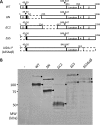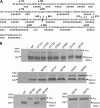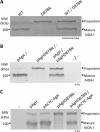Autoprocessing of the Escherichia coli AIDA-I autotransporter: a new mechanism involving acidic residues in the junction region
- PMID: 19398552
- PMCID: PMC2719369
- DOI: 10.1074/jbc.M109.010108
Autoprocessing of the Escherichia coli AIDA-I autotransporter: a new mechanism involving acidic residues in the junction region
Abstract
The cleavage of the autotransporter adhesin involved in diffuse adherence (AIDA-I) of Escherichia coli yields a membrane-embedded fragment, AIDAc, and an extracellular fragment, the mature AIDA-I adhesin. The latter remains noncovalently associated with AIDAc but can be released by heat treatment. In this study we determined the mechanism of AIDA-I cleavage. We showed that AIDA-I processing is an autocatalytic event by monitoring the in vitro cleavage of an uncleaved mutant protein isolated from inclusion bodies. Furthermore, by following changes in circular dichroism spectra and protease resistance of the renaturated protein, we showed that the cleavage of the protein is correlated with folding. With site-directed deletions, we showed that the catalytic activity of the protein lies in a region encompassing amino acids between Ala-667 and Thr-953, which includes the conserved junction domain of some autotransporters. With site-directed point mutations, we also found that Asp-878 and Glu-897 are involved in the processing of AIDA-I and that a mutation preserving the acidic side chain of Asp-878 was tolerated, giving evidence that this carboxylic acid group is directly involved in catalysis. Last, we confirmed that cleavage of AIDA-I is intramolecular. Our results unveil a new mechanism of auto-processing in the autotransporter family.
Figures









Similar articles
-
Proteolytic processing is not essential for multiple functions of the Escherichia coli autotransporter adhesin involved in diffuse adherence (AIDA-I).J Bacteriol. 2006 Dec;188(24):8504-12. doi: 10.1128/JB.00864-06. Epub 2006 Oct 13. J Bacteriol. 2006. PMID: 17041044 Free PMC article.
-
Modular organization of the AIDA autotransporter translocator: the N-terminal beta1-domain is surface-exposed and stabilizes the transmembrane beta2-domain.Antonie Van Leeuwenhoek. 2001 Oct;80(1):19-34. doi: 10.1023/a:1012084325728. Antonie Van Leeuwenhoek. 2001. PMID: 11761364
-
Processing of the AIDA-I precursor: removal of AIDAc and evidence for the outer membrane anchoring as a beta-barrel structure.Mol Microbiol. 1996 Oct;22(1):31-42. doi: 10.1111/j.1365-2958.1996.tb02653.x. Mol Microbiol. 1996. PMID: 8899706
-
Self-associating autotransporters, SAATs: functional and structural similarities.Int J Med Microbiol. 2006 Aug;296(4-5):187-95. doi: 10.1016/j.ijmm.2005.10.002. Int J Med Microbiol. 2006. PMID: 16600681 Review.
-
Strategies for employing molecular genetics to study tip adhesions.Methods Enzymol. 1995;253:229-41. doi: 10.1016/s0076-6879(95)53022-3. Methods Enzymol. 1995. PMID: 7476389 Review. No abstract available.
Cited by
-
Identification and mechanism of evolution of new alleles coding for the AIDA-I autotransporter of porcine pathogenic Escherichia coli.Appl Environ Microbiol. 2012 Jul;78(13):4597-605. doi: 10.1128/AEM.00906-12. Epub 2012 Apr 20. Appl Environ Microbiol. 2012. PMID: 22522689 Free PMC article.
-
Phylogenetic Classification and Functional Review of Autotransporters.Front Immunol. 2022 Jul 1;13:921272. doi: 10.3389/fimmu.2022.921272. eCollection 2022. Front Immunol. 2022. PMID: 35860281 Free PMC article. Review.
-
Engineering Adhesion of the Probiotic Strain Escherichia coli Nissle to the Fungal Pathogen Candida albicans.ACS Synth Biol. 2024 Dec 20;13(12):4027-4039. doi: 10.1021/acssynbio.4c00466. Epub 2024 Sep 12. ACS Synth Biol. 2024. PMID: 39265099 Free PMC article.
-
The translocation assembly module (TAM) catalyzes the assembly of bacterial outer membrane proteins in vitro.bioRxiv [Preprint]. 2024 Jun 20:2024.06.20.599893. doi: 10.1101/2024.06.20.599893. bioRxiv. 2024. Update in: Nat Commun. 2024 Aug 23;15(1):7246. doi: 10.1038/s41467-024-51628-8. PMID: 39372782 Free PMC article. Updated. Preprint.
-
Structure-function analysis of the TibA self-associating autotransporter reveals a modular organization.Infect Immun. 2011 May;79(5):1826-32. doi: 10.1128/IAI.01129-10. Epub 2011 Feb 22. Infect Immun. 2011. PMID: 21343356 Free PMC article.
References
Publication types
MeSH terms
Substances
LinkOut - more resources
Full Text Sources
Other Literature Sources

